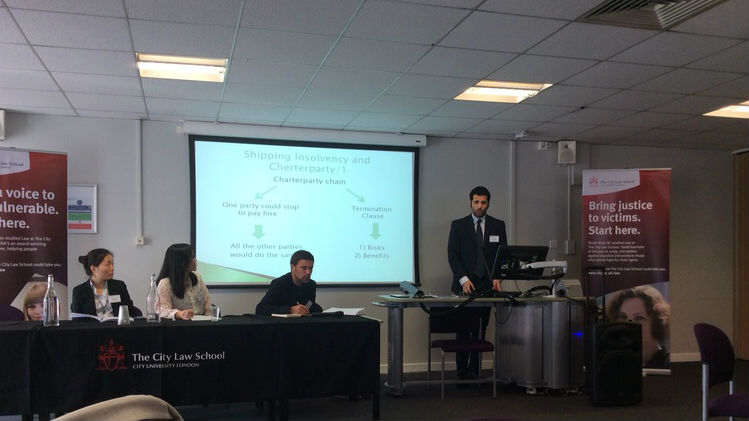Impressions from a London Law Conference

Every year the City University of London hosts a magnificent gathering that draws people from all over Europe and the world and, as in years past, we had the privilege of listening to speakers at the forefront of their discipline hold forth on dozens of topics. The format of the conference - a series of related speaker blocks, with each speaker giving a 15-minute presentation - is ideal for getting quick insight into the contemporary research landscape.
The sessions were divided into Maritime Environment, Policy and Governance, Shipping Liability, Shipping Business, Admiralty Issues and Trends in Shipping. Three or occasionally two speakers shared the one hour in each session, which included a moderated discussion.
Here are our observations on the speakers who provoked the strongest reactions on our part:
Dr. Sarah Fiona Gahlen, a board member of our German American Maritime Institute and a scholar at Kiel University, discussed the new wreck removal convention, which had entered into force on the 14th of April 2015. Most interesting to me was the new P&I Club wreck coverage that owners must purchase, as well as the fact that this P&I Club cover is not available to salvors, only to the flag state.
The idea behind the insurance is to ensure that the flag state can recover the costs of recovery, but the salvor unfortunately will have to rely on direct claims against the owner of the wreck, based on the recovered value. Dr. Gahlen also introduced us to the subtleties of wrecks in the Exclusive Economic Zone (EEZ) and in international waters, as well as the increasing regulation of the EEZ.
Minli Tang gave a brilliant overview of upstream finance for the offshore oil and gas industry with particular emphasis on financing for smaller operators. Project finance is one of the most frequently used instruments, a way of "sandboxing" the risks and rewards. The project itself and its revenue are used as security, leaving out the rest of the company.
Likewise, mezzanine finance (unsecured credit between secured credit and equity), sometimes with an equity "kicker," is used for riskier projects, the goal being to round out the overall return for the lender to approximately 18-20 percent.
In a pure equity situation, on the other hand, the return would be expected to hit anywhere from 25-30 percent. Tang argued that these approaches help to provide investors with an adequate return for the level of risk they are accepting and, as such, make projects possible that bank loans can't, especially when the borrower does not have a strong balance sheet.
Dr. Emma Park delved into the mysteries of English Common Law in light of the case The Bank of Tokyo-Mitsubishi UFJ Ltd v. The Owners of the MV Sanko Mineral v. Glencore Ltd. ("The Sanko Mineral") [2014] EWHC 3927 (Admiralty), 28 November 2014. At debate was the issuance of a statutory claim in rem against a ship (= the res) to the effect that the creditors of the claim could be paid out of the proceeds of the court-ordered sale of the ship.
In this way, the in rem claim attached to the proceeds, not the res - quite the modification, which brings the statutory in rem claim more in line with the maritime lien. Dr. Park argued that this case was, however, an anomaly and not, in fact, good law.
Marta Kolacz then instructed us in the many legal aspects of cargo bundling, a particularly common method of shipping which is gaining prominence amongst smaller shippers. Whether the shippers work through a freight forwarder or other third party intermediary or bundle their cargo independently, as in a joint venture, a myriad of legal issues arises.
In general, the claims of the shippers against each other and - of course - against the freight forwarder are based on the respective corporate law arrangement they have chosen. We found Ms. Kolacz's comments on determining who becomes the contract party to the arrangement in a bundling scenario to be very insightful and valuable, and whether there is one 'lead bundler' or all of the bundlers are jointly and severally liable.
Dr. Sebastian Meyer hit the electronic bill-of-lading debate hard and prompted the undersigned to challenge him to an upcoming debate at the State Maritime College in Cuxhaven.... We look forward to the ultimate throw-down between old-fashioned paper B/Ls and Bolero or ESS systems.
Dr. Meyer discussed the comparison of air shipping and sea shipping and raised the opportunity for transactional savings through the use of electronic waybills, but whether or not this is suitable to ocean shipping is, in our view, dubious. We will be sure to report extensively, and as neutrally as possible, on how this progresses.
All in all it was a great time, and the room was filled with engaged listeners.
To top it all off, at the end of the conference Julia Lessa introduced the new International Transport Law Review, which will be entering into publication toward the end of this year. Audrey and I have been asked to join the board of editors, and we will be conducting peer reviews on topics that are submitted in reference to German and U.S. legal issues. It's an ambitious undertaking and we do, indeed, look forward to the first issue and the end-of-year hard copy compendium. - MarEx
The opinions expressed herein are the author's and not necessarily those of The Maritime Executive.
